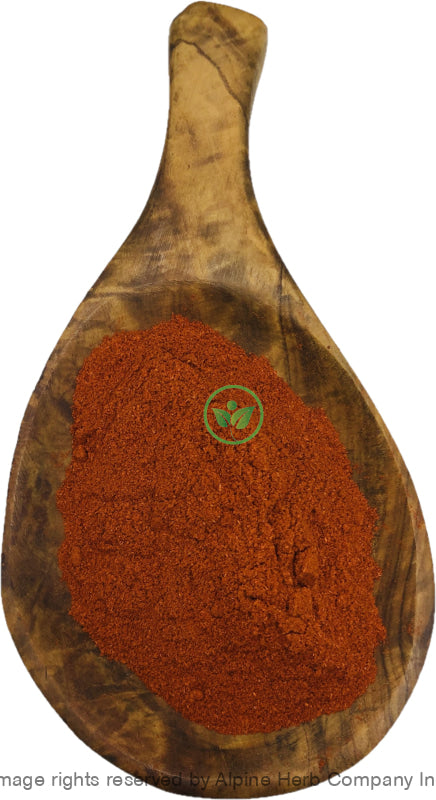Cayenne Pepper Powder Alpine Herb Company Inc.
$ 4,99 $ 2,99
Botanical Name: Capsicum annuum
Common Name:
- English: Chili pepper
- Ayurvedic: Raktamaricha, Lankaa, Katuviraa
- Unani: Mirch, Filfil- e-ahmar, Filfl-e-surkh, Surkh mirch
- Also, known as: rissie, tian jiao, poivron, Spanischer Pfeffer, Chilli,Gewürzpaprika, hara mirh, paprika, pimento, pepperone, peppaa, cabai, Red pepper, Milagay, pimento, pimiento picante, phrik, biber
Habitat: Native to West Indies & Tropical America
Origin: India
Harvested: Cultivated
Parts Used: Fruit
General Information:
The word Capsicum, the genus of cayenne, may have been derived from the Greek kapto, meaning “to bite.” This “bite” is caused by the constituent capsaicin. The more capsaicin a pepper has, the more heat or bite to it. This amount varies greatly among species and varieties.
the fruits are fleshy, hollow berries, very variable in shape and size as a result of domestication and breeding over many centuries. They may be sweet and non-pungent (“sweet peppers” or “capsicum”) or hot (known as “chili peppers” in the USA and as “chillies” or “chilli” in British English). The fruits are used fresh or dry, often as flakes or powder (red pepper), ranging from paprika (mild) to cayenne (moderately hot).
One way of expressing this bite or heat is in Scoville heat units (SHU). Cayenne has around 20,000 to 50,000 SHU. For the sake of comparison, bell peppers have 0 and habaneros have more than 100,000. Other members of the Capsicum genus include bell peppers, chilis, and habaneros. This genus is from the Americas and has been cultivated for at least 7,000 years. Some early explorers brought the seeds from South America to Europe, and they were so loved they quickly spread around the world.
There are many forms of C. annuum, ranging from sweet (bell pepper) to hot (cayenne), including the famous Mexican ‘Jalapeño’ and ‘Serrano’, but also ‘Cascabel’, ‘Catarina’, ‘Chilhuacle’, ‘Costeño’, ‘De Agua’, ‘Fresno’, ‘Guajillo’, ‘Pasilla’, ‘Pequin’, ‘Poblano’ and ‘Pulla’, as well as New Mexico chillies such as the ‘Anaheim
How to use:
As a spice
Precautions:
You should consult with a qualified healthcare practitioner before using any herbal products, particularly if you are pregnant, nursing, or on any medications.
All information on this website is for educational purpose ONLY
This information has not been evaluated by Health Canada.
This information is not intended to diagnose, treat, cure, or prevent any disease.
| Unit Size | 100g, 200g, 400g, 1kg |
|---|
Prompt shipping and expert packing
Thanks to our longstanding association with UPS FedEx DHL as well as other leading global carriers, we can offer a variety shipping options. Our warehouse staff is highly trained and will be able to pack your goods in accordance with our precise and exact specifications. Your items will go through an exhaustive examination before they will be securely packaged before being delivered. We ship to hundreds of thousands of customers daily in different countries. This is a sign of our determination to become the largest online retailer worldwide. Warehouses and distribution centers are located throughout Europe as well as in the USA.
Note that orders containing multiple items are processed according to the particular item.
We will thoroughly inspect all items ordered before shipping. Most orders are shipped within 48 hours. The delivery time will be between 3 and 7 working days.
Returns
The stock market is always changing. It's not entirely managed by us since we're involved with several entities, including the factory and the storage. Therefore, the actual inventory could fluctuate at any moment. Please be aware that it is possible that your order could be out of stock after you've placed your order.
Our policy lasts for 30 days. If it's been more than 30 days since the date you purchased your item We're sorry to say that we can't offer you a full exchange or refund.
You can only return a product if it is unused and still in the same state as when you received it. The item should be in the original packaging.
Related products
Spices Powder
Spices Powder
Spices Powder
Spices Powder
Spices Powder
Spices Powder
Spices Powder
Spices Powder
Spices Powder
Spices Powder
Herb Powder
Spices Powder
Spices Powder
Spices Powder
Spices Powder
Spices Powder
Spices Powder
Spices Powder
Spices Powder
Spices Powder
Spices Powder
Spices Powder
Spices Powder
Herb Powder
Spices Powder
Spices Powder
Spices Powder
Spices Powder
Spices Powder
Spices Powder


































